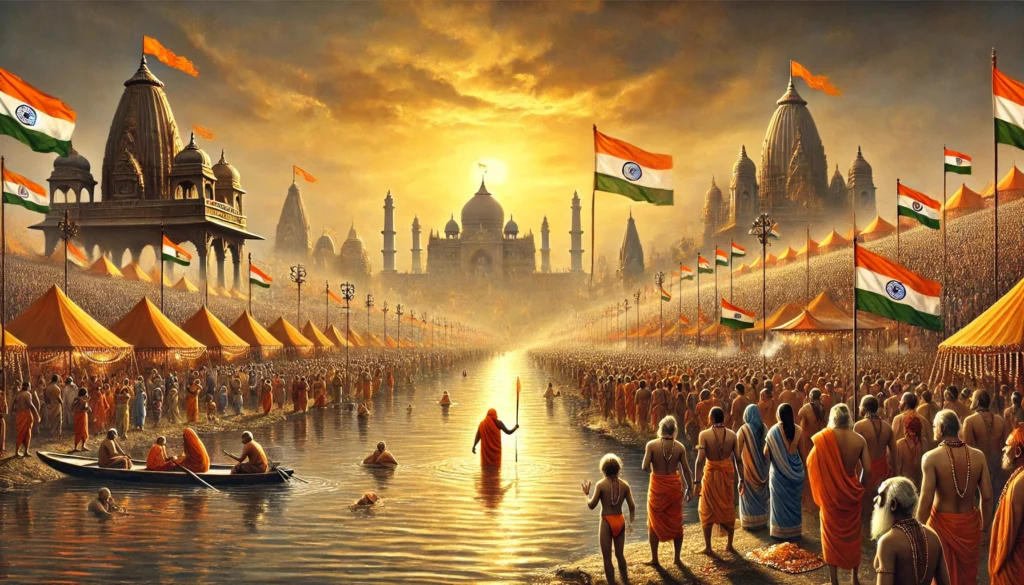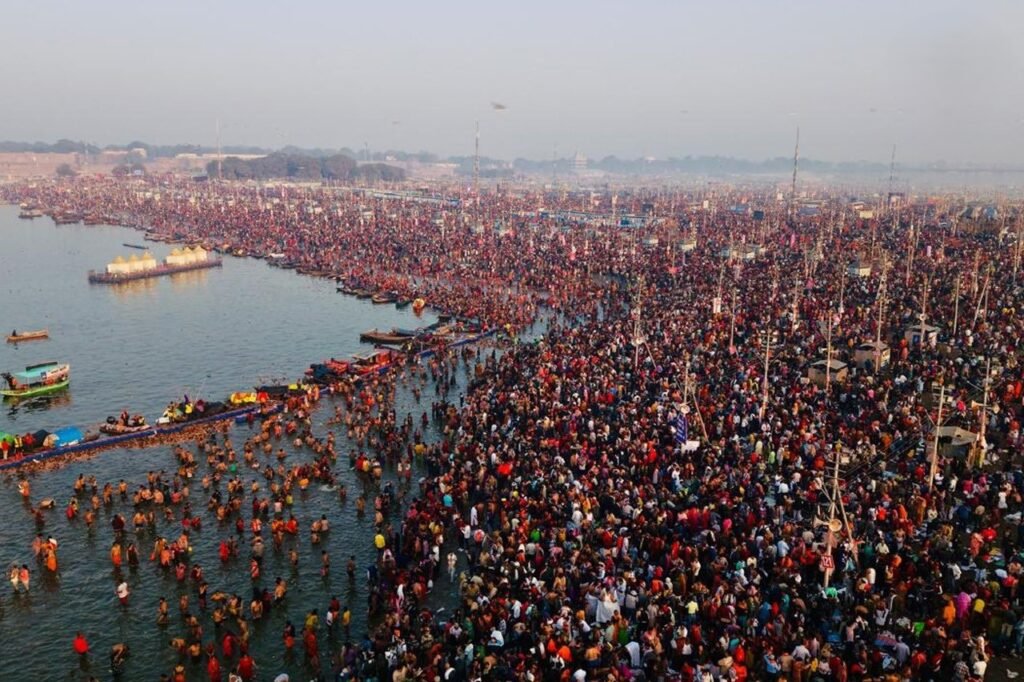
Mahakumbh 2025: The year 2025 marks a momentous occasion in the spiritual and cultural history of India—the grand Mahakumbh, the largest religious congregation on the planet. More than 500 million devotees have already taken the sacred dip in the holy rivers of Prayagraj, signaling not just an unprecedented turnout but also an unmistakable resurgence of Sanatan Dharma in the modern era.
The magnitude of this event and its profound cultural and political implications suggest that Mahakumbh 2025 could be a defining moment in the transformation of India’s socio-religious landscape.
Mahakumbh 2025: A Cultural Phenomenon Rooted in Sanatan Dharma
The Kumbh Mela, held every 12 years in a cycle across four locations—Prayagraj, Haridwar, Nashik, and Ujjain—traces its origins back thousands of years. It is deeply interwoven with Hindu Dharma, where the celestial event commemorates the battle between devas (gods) and asuras (demons) over the pot (kumbh) of amrit (nectar of immortality).

The significance of Mahakumbh extends beyond mere religious observance; it is a spiritual confluence of seekers, saints, scholars, and devotees, reinforcing the eternal values of Sanatan Dharma.
Mahakumbh 2025, with its record-breaking participation, has illuminated the reawakening of India’s ancient traditions. The participation of diverse sects of Hinduism—from Shaivites and Vaishnavites to various Akharas—showcases the unity in spiritual diversity that has been the bedrock of Indian civilization.
This rekindling of faith, cultural pride, and ancient traditions signifies that Sanatan Dharma is experiencing a revival, ensuring that the wisdom of the Vedas, Upanishads, and Puranas remains relevant even in contemporary times.
The Cultural Renaissance and India’s Future
1. Reclaiming India’s Ancient Identity
India’s cultural identity, often overshadowed by colonial and modern influences, is seeing a renaissance through events like Mahakumbh. The unprecedented turnout, particularly among the younger generation, highlights an increasing interest in rediscovering India’s civilizational roots.
The rejuvenation of Sanskrit studies, temple restoration projects, and the renewed emphasis on Yoga and Ayurveda all stem from this cultural resurgence. Mahakumbh 2025 is acting as a catalyst for this shift, pushing the country towards reclaiming its spiritual and historical ethos.
A significant marker of this revival is the restoration of the Ayodhya Ram Temple, a project that symbolizes the reclaiming of Hindu heritage and faith. The struggles for the restoration of the Gyanvapi Temple in Kashi and the Krishna Janmabhoomi temple in Mathura further underscore the broader movement towards reinstating India’s sacred landmarks.
These efforts are not just about reclaiming religious sites but also about restoring India’s cultural memory and spiritual sovereignty.
2. Strengthening Hindu Solidarity
The sheer scale of Mahakumbh fosters a sense of unity among Hindus globally. With diaspora participation from the United States, the United Kingdom, Australia, and several other countries, the event underscores the role of Hinduism as a unifying force across borders. This solidarity is essential in countering divisive narratives that seek to fragment India’s social fabric.
3. Impact on Pilgrimage-Based Tourism and Economy
The influx of millions into cities like Prayagraj generates enormous economic benefits. With infrastructure development, employment opportunities, and a boost to local businesses, pilgrimage-based tourism is becoming a crucial pillar of India’s economic growth. This sector is expected to expand significantly as more people reconnect with their spiritual heritage, strengthening the economic underpinnings of India’s cultural revival.
Political Implications of Mahakumbh 2025: Will It Reshape India’s Future?
Mahakumbh 2025 is not just a spiritual event; it has significant political ramifications. The rise of cultural nationalism, the assertion of Hindu identity in policymaking, and the resurgence of Sanatan values in governance point towards a new socio-political order. Here are the key political shifts that might emerge.
1. The Growing Influence of Hindutva in Politics
With an increasing number of people aligning with Sanatan values, political parties are recognizing the importance of Hindu-centric policies. The government’s active participation in organizing and facilitating the Mahakumbh reflects a deeper alignment with cultural nationalism. This could lead to policy changes favoring temple autonomy, heritage conservation, and the promotion of Indic knowledge systems in education.
The Bharatiya Janata Party (BJP) and the present government have played a crucial role in this cultural revival. While publicly upholding the principles of secular governance, there have been concerted efforts to reclaim and restore Hindu heritage sites.

From facilitating the grand opening of the Ayodhya Ram Temple to supporting initiatives for the revival of Kashi Vishwanath and Mathura temples, the government’s policies reflect an underlying commitment to the resurgence of Sanatan Dharma. The promotion of Indian traditions, the reintegration of Hindu scriptures in education, and the global advocacy for Hindu cultural heritage are further indicators of this shift.
2. A Potential Shift Towards a Hindu Rashtra?
The idea of a Hindu Rashtra has been a topic of intense debate. While critics argue that it may compromise India’s secular fabric, proponents believe that a Hindu Rashtra is not about exclusion but about the reaffirmation of India’s core civilizational principles.

Mahakumbh 2025, with its overwhelming participation, signals a mass awakening that could potentially pave the way for the institutionalization of Hindu-centric governance. The BJP’s policies, combined with increasing grassroots support for Hindu causes, indicate a long-term trajectory where Hindu identity becomes central to India’s political framework.
3. Political Mobilization Through Cultural Sentiments
The participation of saints, religious leaders, and spiritual organizations in Mahakumbh gives them a powerful voice in shaping India’s policy discourse. The push for a Uniform Civil Code (UCC), the protection of temples from state control, and the broader decolonization of Indian education are increasingly becoming mainstream political issues.
Mahakumbh acts as a platform to consolidate public opinion in favor of these reforms, aligning with the government’s hidden yet strategic efforts to integrate Sanatan values into governance.
4. The Global Impact of Hindu Renaissance
Hindu organizations worldwide, inspired by Mahakumbh, are actively working towards countering the misrepresentation of Hinduism in global academia and media. The success of Mahakumbh 2025 will likely strengthen Hindu advocacy efforts on international platforms, pushing for greater recognition of Hindu contributions to global civilization.
The Indian government’s diplomatic push in highlighting Indian culture—such as International Yoga Day—further signals a calculated effort to project Hinduism’s global influence.
Challenges and the Road Ahead
While Mahakumbh 2025 signals a powerful resurgence of Sanatan Dharma, several challenges remain.
- Balancing Tradition with Modernity: As India progresses technologically and economically, integrating ancient wisdom with modern governance and scientific advancement will be crucial.
- Avoiding Sectarianism: While cultural nationalism is gaining ground, ensuring that it remains inclusive and not divisive is essential for India’s social harmony.
- Environmental Concerns: Large-scale events like Mahakumbh pose significant environmental challenges. Sustainable pilgrimage management must be prioritized to maintain ecological balance.
Conclusion: Mahakumbh 2025 Is a Pivotal Moment in India’s History
Mahakumbh 2025 is not just a religious gathering; it is a cultural phenomenon that could redefine India’s future. The revival of Sanatan Dharma, the resurgence of Hindu consciousness, and the political and social ramifications of this event make it a turning point in India’s civilizational journey. Whether it paves the way for a Hindu Rashtra or simply strengthens India’s cultural identity, Mahakumbh 2025 is undoubtedly a harbinger of transformation.
India stands at the crossroads of history, witnessing a rekindling of its ancient soul. What direction it takes from here will depend on how this renewed cultural consciousness is channeled—whether towards a balanced and inclusive resurgence or an assertive political realignment.
One thing, however, is certain: the echoes of Mahakumbh 2025 will resonate far beyond the banks of the Ganges, shaping the cultural and political discourse of India for generations to come.
You can follow us on social media platforms.



